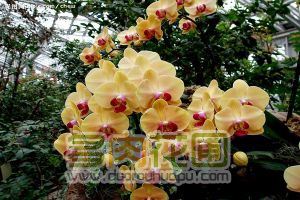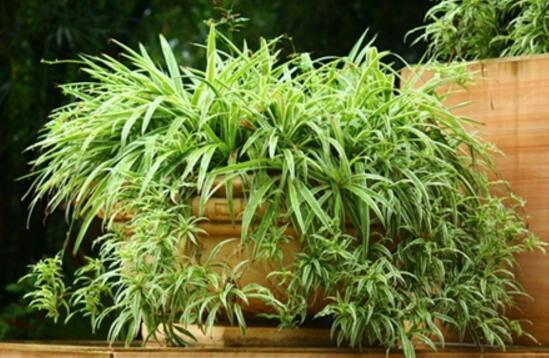The reason why Phalaenopsis does not blossom or wither
It takes about 2 years for Phalaenopsis to blossom from seedling to flower, and most adult plants blossom around the Spring Festival every year. However, the Phalaenopsis cultivated by some flower growers simply do not bloom, or although they form buds, they are withered and yellow, which deeply disappoints many flower friends.
The main reasons are as follows:
Dry air, insufficient watering or strong light in ① cultivation environment will cause wilting and yellow withering of leaves and affect flower bud differentiation and flowering.
If the ② temperature is too high or too low, it will not only inhibit plant growth, but also affect flower bud formation without flowering. Phalaenopsis likes the environment with higher temperature, even if the buds are formed, such as the indoor temperature is too low to meet the requirements of flowering, the buds will shrink and fall off and cannot blossom.
When the proportion of ③ fertilizer is out of balance, too much nitrogen fertilizer and lack of phosphorus and potassium fertilizer will also affect flower bud formation, no flowering or few flowering. Excessive fertilization, especially after pregnant buds, is easy to cause buds withered, yellow and early.
④ watered carelessly and splashed water on the flower heart at the base of the leaf. The stagnant water led to the rot of the leaf base, resulting in poor plant growth and affecting flowering. Therefore, when spraying water, it is appropriate to spray the leaf surface with the method of spraying to avoid spraying to the growing point. Do not spray water on the flower after the bud is formed, so as not to cause the bud to fall.
⑤ air is not ventilated, especially during flowering, if the air is stagnant at this time, the top of the flower stem is easy to wither, resulting in orange early fall of the bud.
If the plant material of ⑥ is alkaline, or if it is irrigated with alkaline water and fertilizer for a long time, it will affect the root system to absorb water and nutrients, which is also one of the reasons why Phalaenopsis does not bloom. In addition, when the flowers are in bloom, the withered flowers should be cut off as soon as possible, which can reduce the consumption of nutrients in the body. Otherwise, it is not conducive to the growth and flowering of orchids in the following year.
The reason why Phalaenopsis does not blossom or wither

Main reasons and analysis
The air of cultivation environment is dry.
Excessive strong light exposure and insufficient water supply will lead to wilting and yellowing of leaves, which is disadvantageous to flower bud differentiation and flowering.
The temperature is not properly controlled
Poor temperature control will also hinder the normal development of plants and hinder the growth of flower buds and prevent them from blooming. Phalaenopsis is suitable to be cultivated in a high temperature environment, even if there are buds sprouting, if the indoor temperature is too low, it will make the buds withered and early fall, which can not meet the requirements of flowering.
Imbalance of fertilization proportion
Excessive nitrogen application and lack of phosphorus and potassium fertilizer will also inhibit flower bud differentiation, resulting in non-flowering or less flowering. If the concentration of fertilizer is too high, especially after the formation of flower buds, it is easy to make the buds wither. If alkaline water and fertilizer is applied for a long time, it will hinder the root system to absorb water and nutrients, making it difficult for Phalaenopsis to bloom.
Careless watering
When watering, if water splashes into the flower center at the base of the leaf, it will cause the rot of the leaf base and make the plant grow abnormally and affect the flowering. Therefore, when spraying water, the leaf surface can be sprayed to prevent mistakenly spraying to the growing point. When the bud is formed, stop spraying water to the flower to avoid the occurrence of bud drop.
Poor ventilation
Flowering period should pay special attention to proper ventilation, if the air circulation is not smooth, it is easy to make the top of the flower stem withered and withered, and there will be buds falling.
What is the reason why Phalaenopsis does not bloom or wither?
It takes about 2 years for Phalaenopsis to blossom from seedling to flower, and most adult plants blossom around the Spring Festival every year. However, some Phalaenopsis do not blossom, or although they form buds, they turn yellow and fall early. There are mainly the following aspects to investigate the reasons.
Dry air, underwatering or strong light will cause wilting and yellow withering of leaves and affect flower bud differentiation and flowering.
If the temperature is too high or too low, it will not only inhibit plant growth, but also affect flower bud formation without flowering. Phalaenopsis likes a higher temperature environment, even if the formation of buds, such as indoor temperature is too low, the buds will shrink and fall off.
The proportion of fertilization is out of balance, too much nitrogen fertilizer and lack of phosphorus and potassium fertilizer will also affect flower bud formation, do not bloom or rarely bloom. Excessive fertilization, especially after pregnant buds, is easy to cause buds withered, yellow and early.
Watering carelessly, the water was spilled to the flower heart at the base of the leaf, and the stagnant water led to the rot of the leaf base, resulting in poor plant growth and affecting flowering. Therefore, when spraying water, it is appropriate to spray the leaf surface with the method of spraying to avoid spraying to the growing point. Do not spray water on the flower after the bud is formed, so as not to cause the bud to fall.
Poor ventilation will have adverse effects, especially during flowering, if the air is stagnant at this time, the top of the flower stem is easy to wither, resulting in withered and yellow buds.
In addition, when the flowers are in bloom, the withered flowers should be cut off as soon as possible, which can reduce the nutrient consumption in the body, otherwise it is not conducive to the growth and flowering of orchids in the following year.
- Prev

How to cultivate, maintain and reproduce green pineapple?
Green pineapple is a perennial evergreen vine. The stem vine is thin and soft, with aerial roots at internodes, leaves heart-shaped or long oval, with irregular, golden stripes or markings, thick and bright, entire. Green pineapple likes warmth, shade tolerance and cold fear, and grows well in fertile, loose sandy loam and humid environment. So
- Next

Why do the leaves of Cymbidium turn black and die?
Generally speaking, the leaf color of Cymbidium is white and pale, which is due to strong sun exposure; the leaf color is yellow and withered because of insufficient nutrients or long-term drying of basin soil; the leaves turn black and fall off because of too much watering and too much fertilization. The preventive measures are as follows: every year before Ching Ming Festival, the ① should turn the basin and change the soil to replenish the nourishment.
Related
- Fuxing push coffee new agricultural production and marketing class: lack of small-scale processing plants
- Jujube rice field leisure farm deep ploughing Yilan for five years to create a space for organic food and play
- Nongyu Farm-A trial of organic papaya for brave women with advanced technology
- Four points for attention in the prevention and control of diseases and insect pests of edible fungi
- How to add nutrient solution to Edible Fungi
- Is there any good way to control edible fungus mites?
- Open Inoculation Technology of Edible Fungi
- Is there any clever way to use fertilizer for edible fungus in winter?
- What agents are used to kill the pathogens of edible fungi in the mushroom shed?
- Rapid drying of Edible Fungi

